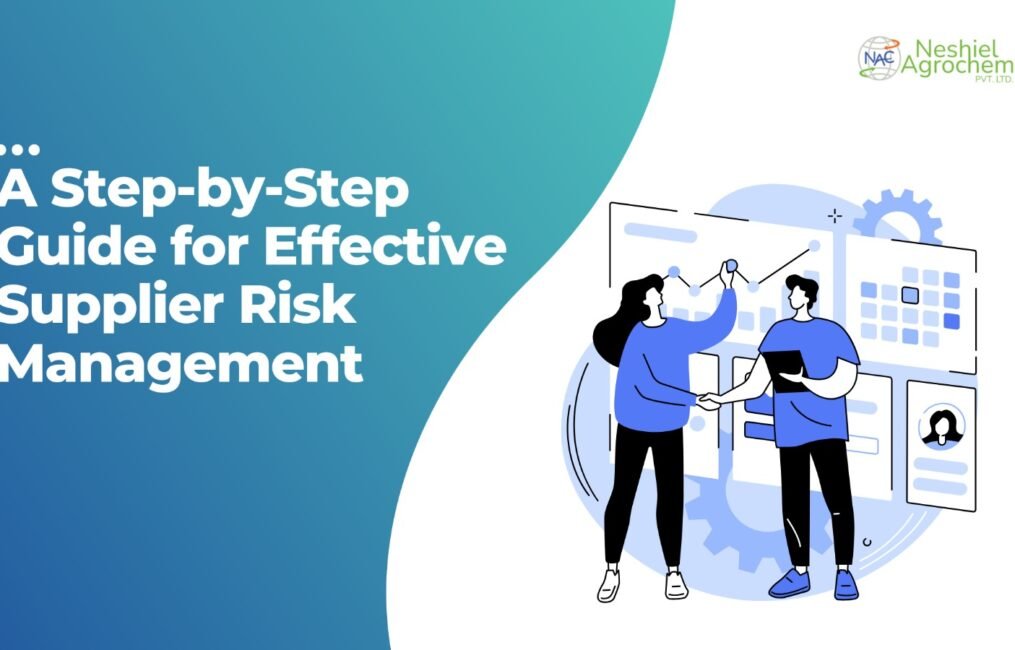A Step-by-Step Guide for Effective Supplier Risk Management

In today’s interconnected global economy, businesses depend heavily on suppliers to deliver quality materials, products, and services on time. However, this dependency also comes with significant risks. From financial instability to regulatory non-compliance and geopolitical disruptions, supplier-related risks can adversely impact your business’s operations, reputation, and bottom line. Effective supplier risk management (SRM) is essential for mitigating these risks and ensuring a resilient supply chain.
This comprehensive guide provides a step-by-step approach to managing supplier risk effectively, helping organizations safeguard their operations and maintain supplier relationships.
Why Is Supplier Risk Management Important?
Supplier risk management goes beyond cost optimization; it is about ensuring business continuity and maintaining competitive advantages. Here’s why it matters:
- Mitigates Disruptions: Unexpected disruptions, such as natural disasters or supplier insolvency, can halt operations. SRM helps minimize these risks.
- Ensures Compliance: Many industries require compliance with strict regulations. Non-compliance by a supplier can lead to legal repercussions.
- Safeguards Reputation: A single supplier’s unethical practices can damage your company’s brand image.
- Optimizes Costs: Identifying high-risk suppliers can save costs by avoiding sudden price hikes or poor-quality goods.
- Supports Sustainability Goals: Responsible sourcing ensures that environmental and social standards are upheld.
Step 1: Identify Potential Risks
The first step in supplier risk management is understanding the types of risks that can arise. These may include:
| Risk Type | Description |
| Financial Risks | Supplier’s financial instability leading to failure in meeting obligations. |
| Operational Risks | Issues such as capacity constraints, delivery delays, or quality failures. |
| Regulatory Risks | Non-compliance with industry standards or legal requirements. |
| Geopolitical Risks | Impact of political instability, trade restrictions, or sanctions. |
| Cybersecurity Risks | Potential for data breaches or system vulnerabilities in supplier operations. |
| Environmental Risks | Non-adherence to sustainability standards or environmental regulations. |
Step 2: Conduct a Supplier Risk Assessment
A detailed risk assessment helps prioritize suppliers based on their risk levels. Follow these steps:
1. Supplier Segmentation
- Classify suppliers into categories based on criticality, such as strategic, operational, and transactional.
- Focus on high-impact suppliers who play a crucial role in your operations.
2. Gather Risk Data
- Financial health reports.
- Audit reports and certifications.
- Historical performance data.
- Market intelligence and news monitoring.
3. Risk Scoring
- Assign scores to each supplier based on parameters like financial health, compliance, and delivery performance.
- Use tools such as heat maps or risk matrices for visualization.
Step 3: Develop a Risk Mitigation Plan
Once risks are identified and assessed, the next step is to create a mitigation plan. Strategies include:
- Diversify Supplier Base
- Avoid over-reliance on a single supplier by sourcing from multiple vendors.
- For critical materials, maintain backup suppliers in different regions.
- Establish Contingency Plans
- Develop action plans for potential disruptions, such as natural disasters or supplier bankruptcy.
- Examples include stockpiling critical materials or having alternative transport routes.
- Set Clear Contracts
- Define terms for quality, delivery timelines, and compliance in supplier contracts.
- Include penalty clauses for non-performance.
- Monitor and Audit
- Conduct regular audits of supplier processes, focusing on quality and compliance.
- Monitor real-time data for early detection of issues.
Step 4: Implement Technology Solutions
Technology plays a crucial role in modern supplier risk management. Consider these tools:
| Technology | Features |
| Supplier Management Software | Centralized database for supplier information and performance metrics. |
| Predictive Analytics | Forecast potential risks based on historical and market data. |
| Blockchain Solutions | Ensure transparency and traceability in the supply chain. |
| Cybersecurity Tools | Protect sensitive data shared with suppliers. |
Integrating these technologies ensures a proactive approach to risk management and enhances supplier collaboration.
Step 5: Build Strong Supplier Relationships
Building strong relationships with suppliers can reduce risks by improving communication and collaboration. Best practices include:
- Regular Communication
- Schedule regular meetings to discuss expectations, performance, and potential challenges.
- Use digital collaboration tools to ensure real-time updates.
- Training and Development
- Offer training sessions for suppliers to align with your company’s quality and compliance standards.
- Share best practices to improve their processes.
- Long-Term Partnerships
- Establish mutually beneficial long-term contracts.
- Provide incentives for meeting or exceeding performance standards.
Step 6: Monitor and Review Continuously
Supplier risk management is an ongoing process that requires regular monitoring and review. Steps include:
- Real-Time Monitoring
- Use dashboards and analytics to track supplier performance in real-time.
- Identify trends and anomalies that may indicate potential risks.
- Periodic Reviews
- Conduct semi-annual or annual reviews to evaluate supplier performance against KPIs.
- Update risk assessments and mitigation plans based on new data.
- Feedback Loops
- Solicit feedback from internal stakeholders about supplier performance.
- Use this input to refine strategies and enhance supplier collaboration.
Challenges in Supplier Risk Management
Despite its importance, supplier risk management comes with its own set of challenges:
- Data Availability: Limited access to reliable and real-time data.
- Cost Implications: High costs associated with technology and compliance audits.
- Supplier Resistance: Lack of cooperation from suppliers in providing necessary information.
- Dynamic Risks: Rapidly changing market conditions and geopolitical factors.
Overcoming these challenges requires a combination of technology, expertise, and strategic planning.
Conclusion
Effective supplier risk management is critical for ensuring business continuity, maintaining compliance, and safeguarding your company’s reputation. By identifying risks, conducting thorough assessments, and implementing robust mitigation plans, businesses can build resilient supply chains capable of withstanding disruptions.
For industries like chemicals, edible oils, flavors & fragrances, and industrial materials, a proactive approach to supplier risk management is non-negotiable. By leveraging technology, building strong supplier relationships, and continually monitoring performance, organizations can turn supplier risk management into a strategic advantage.

